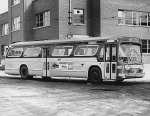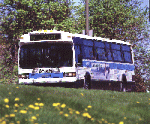In the early nineteenth century, Montreal’s urban transit network consisted primarily of a railway system for the tram. This became problematic in 1919, especially on Bridge Street, because the short road was crossed by multiple tram tracks which connected the local factories to the national railway system. The tram had been created in 1893, and by 1919 the system had to be renewed. However, this was estimated to be costly and as a result the Montreal Tramways Company decided to integrate buses into their transport system. These became known as “trackless” tramways.
The Montreal bus system was first launched on November 22, 1919 on St- Étienne Street, also known as Bridge Street. This street was important as it was the main passageway to the Victoria Bridge.
The first buses were created from white trucks and were relatively simple in terms of design. Each bus had two benches facing each other along the walls of the bus and there were a few straps for people who were forced to stand, and like today, there was ad space. These early buses were extremely uncomfortable, very cold during the winter, and were known for shaking around their passengers. French Montrealers developed the nickname “chars a bancs” (wagon with benches) for these buses, who were referred to by the company as numbers 50 and 51.
 |
| First Bus Used in Montreal |
 |
| Interior of the First Bus in Montreal |
In 1921, two more buses were added and these were numbers 60 and 61. They were summer buses and as a result they were open vehicles. They travelled between Berri Street and Craig Street (today’s St Antoine) and the Victoria Pier. At the Pier passengers could get on the ferry to the South Shore, this was before the construction of the Montreal Harbour Bridge/Jacques Cartier Bridge today (which was opened on May 24, 1930).
In 1925, the Montreal Tramway Company created a bus division. As a result they created new buses which were put into regular service between Montreal West and Lachine. This same year, a “deluxe” service was created on Sherbrooke and St Hubert Street. 1925, was an important year for the Montreal bus system as it is when it started to become popular. As a result of its popularity, fifty-six more buses were purchased and these featured many improvements which intended to increase passenger comfort. The seats were upholstered and there was heating for cold days.
 |
| Yellow Coach Bus, 1925 |
 |
| Interior of Yellow Coach Bus |
Despite these advances, the Company was still not certain about the success of the bus system, In an Annual Report from 1926 it was written “Your Directors, however, desire to point out that the Autobus service is only on trial and that the increased service is given with a view of meeting the wishes of the public and in an endeavour to relieve the traffic congestion." However, in 1927 there was a change of heart and buses were declared to replace all tramway lines. This was decided as it coincided with the widening of Guy street and it seemed logical to remove the tramway rails at the same time, to make way for new bus routes.
In 1930, the Company tried out British buses from the Leyland Co. firm. The prices and the quality of these buses appeared to be excellent due to the competition that had developed between manufacturers and these ones in particular had a more luxurious interior.
 |
| Leyland Bus |
 |
| Luxurious Interior of Leyland Bus |
The nineteen thirties were difficult times due to the depression, and this was reflected in the Company as they waited four years before purchasing any new buses.
In 1934, representatives of the Company went to England to observe their transit system and understand how it operated. From their observations, they concluded that trolley cars were still popular for transportation in “cities the size of Montreal” but that trolley and gas buses were just as important.
Due to the 1934 study, in 1935 the Company implemented a trolley bus on Beaubien Street to test its success. In 1936, the tramway network shrank even further when the railways were removed from Notre-Dame street east of George V as well as on Broadway in Montreal East where it was replaced by a bus system.
On March 29, 1937, trolley service began on Beaubien Street. Seven vehicles from England were used as they were considered to be “the finest vehicles of this type now in operation” according to tramway officials. By the end of the year, the Company was satisfied with the trolley and were especially content that the estimated cost had been accurate
The first half of the forties demonstrated a peak in urban transit riders. This was due to the war and the necessity of transporting workers to the war factories. However, most of the nation’s industrial production was centered around producing army supplies and therefore it was difficult to buy new transit vehicles.
In the post war years there was a boom of automobile usage and this caused traffic jams which increased public transportation operation costs. However, more maintenance depots were redesigned to be accessible to buses.
On June 6, 1951, transit authority became public property under the responsibility of the Montreal Transportation Commission due to a new Quebec by-law. The new administration decided to get rid of all tramways and replace them with buses. This was done rather quickly, over an eight year period it was completed. The last tramway car passed through Montreal on August 30, 1959. The overhead wiring was kept for a few more years as it was used by trolley buses, however it was taken down when the metro was introduced in 1966.
Another project taken on by the new Commission was to standardize the buses, there were many different models is use when they took over in 1951. They chose diesel powered Canadian Car/Brill buses, the frames of the cars were built by the Canadian Car Foundry in Lachine and they had a Brill Motor from England. These were used from the 50’s to early 80’s
 |
| Canadian Car with British Brill Engine |
In 1959, the “New Look” bus model was created, these models can still be seen in Montreal today.
 |
| "New Look" Bus |
The nineteen-eighties introduced the “Classic” model
 |
| "Classic" Bus |
Finally, the nineteen-nineties saw the creation of the “Novabus”. These were a huge change from previous buses because it is a low-floor bus, this aided access for seniors and created better wheel chair access as well. At first there were some mechanical problems, and in 1999 all low floor buses were withdrawn for a period of two weeks in the winter due to mechanical failure. Nevertheless they are gaining in popularity today especially due to the recent changes.
 |
| "Novabus" |
1893
- The Tramway was created
1919
- November 22, 1919 the city’s first bus service was launched on St Étienne Street (or Bridge Street)
1921
- Buses 60 and 61 were added, and they moved between Berri and Craig Street as well as the Victoria Pier
1925
- The Montreal Tramway Company created a bus division, new buses were put into service between Montreal West and Lachine
- “Deluxe” service was created on Sherbrooke and St Hubert Street
- 56 buses purchased due to increased popularity
1926
- The Company still uncertain about the success of the bus
1927
- Buses were declared to replace all tramways in the city
1930
- The company tries British manufactured buses with luxurious interiors
- No buses purchased for four years due to depression
1934
- Company representatives went to England to observe their transportation system
1935
- Trial trolley bus set up on Beaubien Street
1936
- Tramways on Notre-Dame and Broadway (Montreal East) were replaced by a bus system
1937
- March 29, 1937, trolley system implemented on Beaubien Street
1940
- Transit systems packed with transporting workers to war factories during the forties
1951
- On June 6, 1951, transit authority became public property under the responsibility of the Montreal Transportation Commission due to a by-law
1959
- On August 30, 1959, the last tramway car passed through the city
- Introduction of the “New Look” buses
1966
- The metro system opened in Montreal
1980
- “Classic” bus model introduced
1990
- “Novabus” bus model introduced
References:
STM, History of the Bus in Montreal, http://www.stm.info/english/en-bref/a-autobus.htm, accessed November 18, 2010
Veilleux, Denis. "Buses, Tramways, and Monopolies: The Introduction of Motor Vehicles into Montreal's Public Transit Network" Michigan Historical Review vol. 22, No. 2 (1996): 103-126.